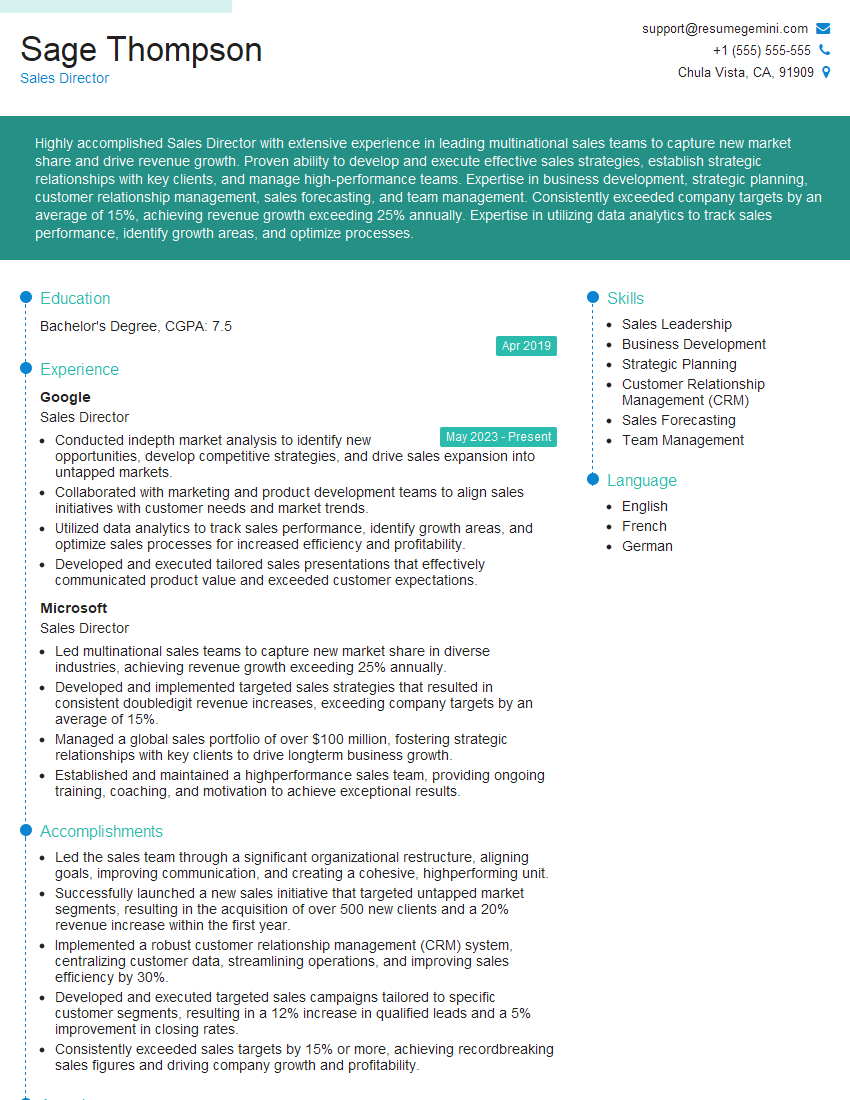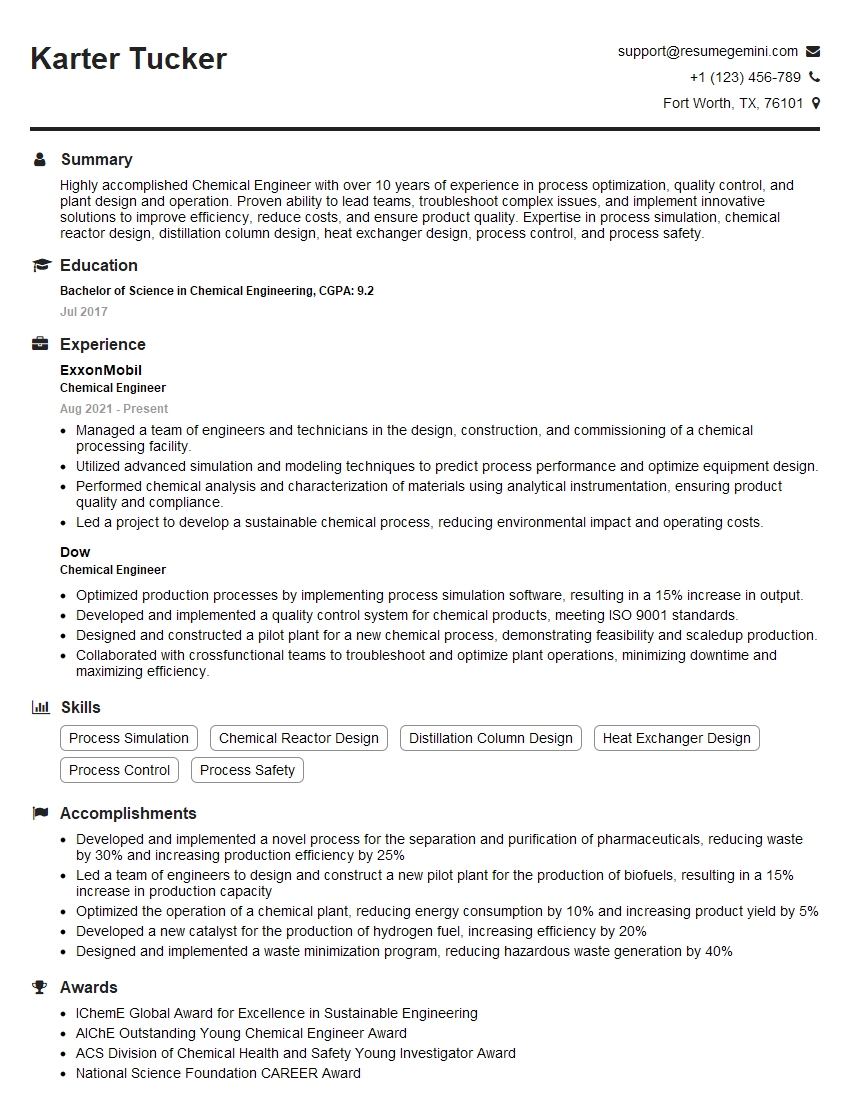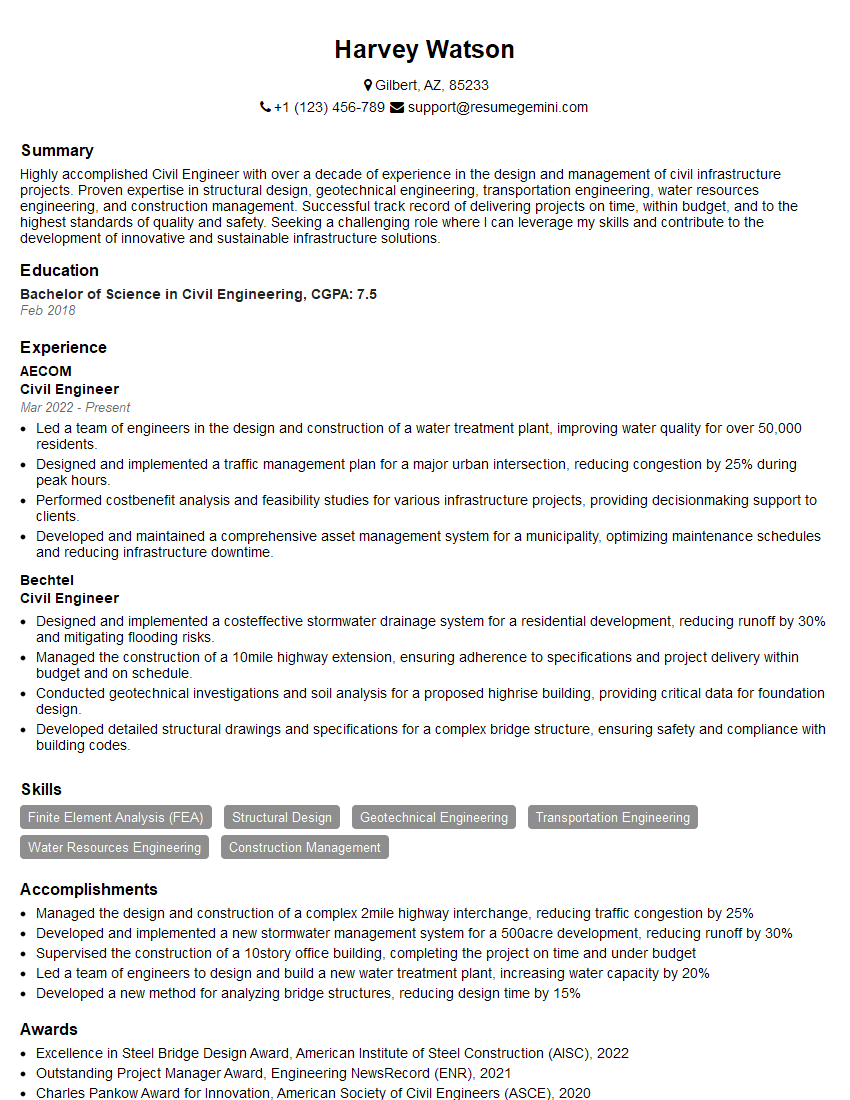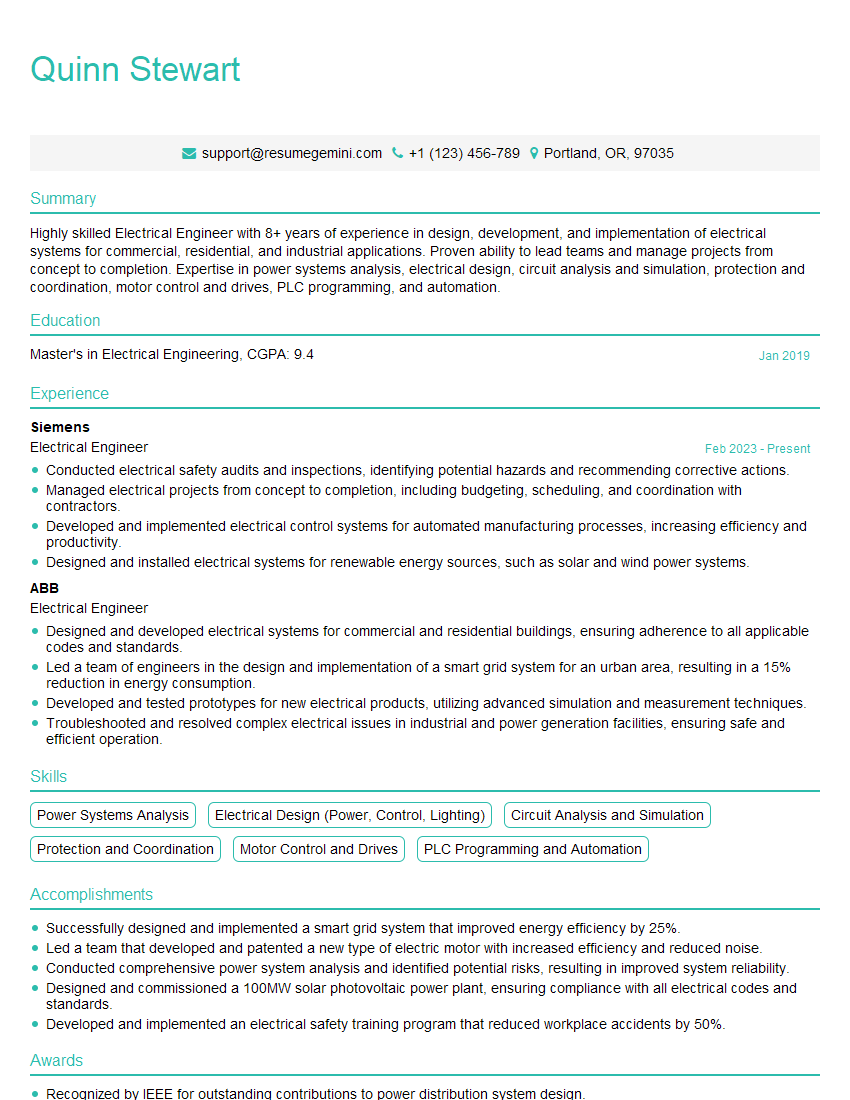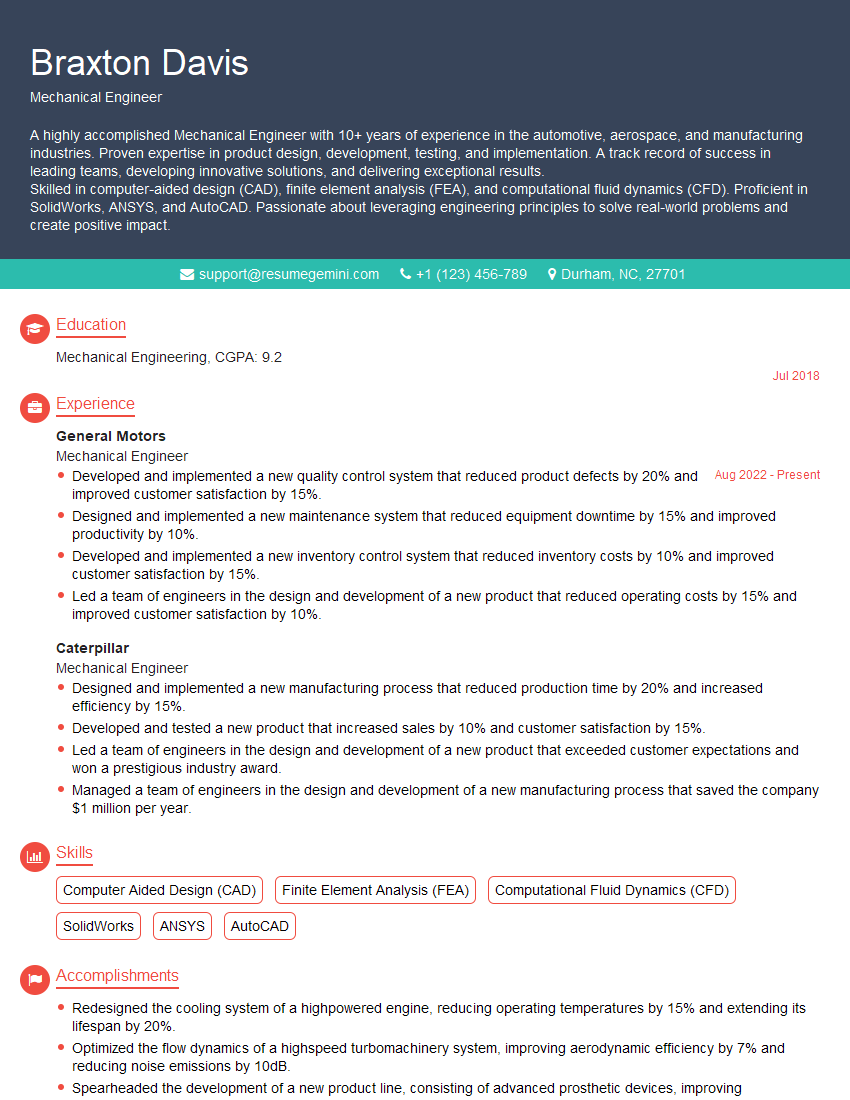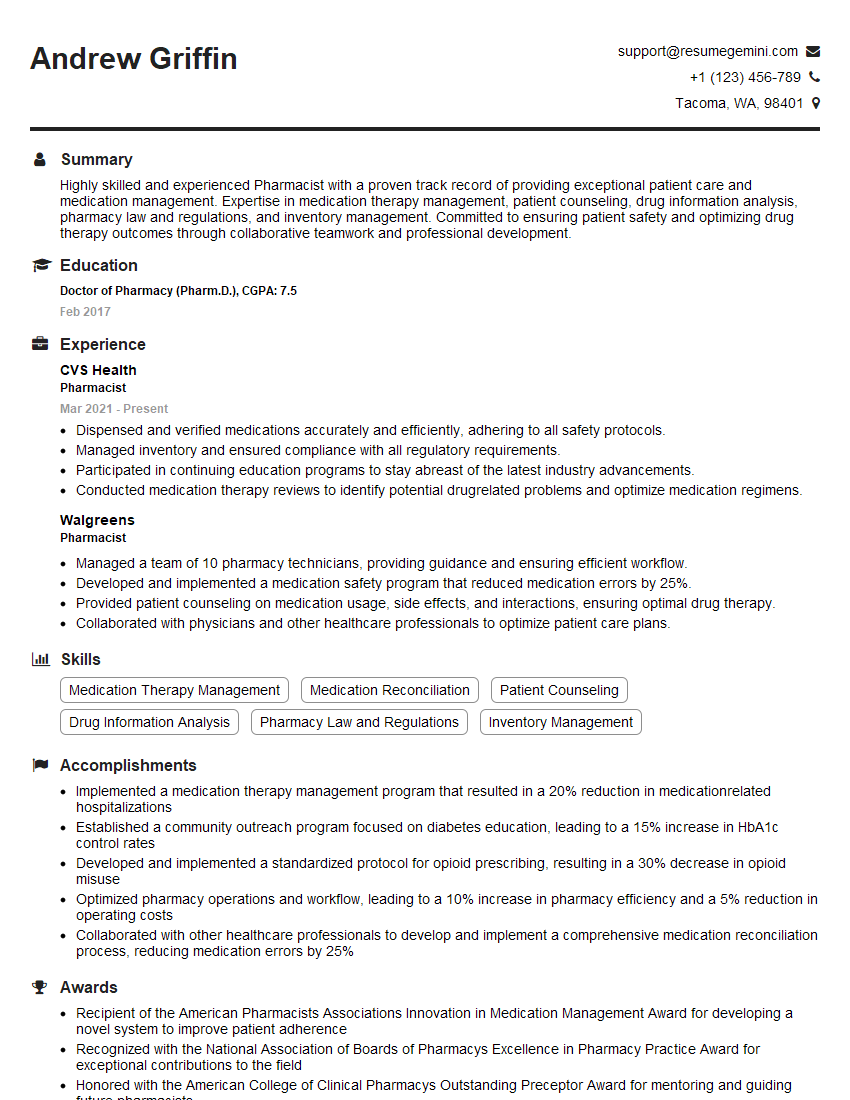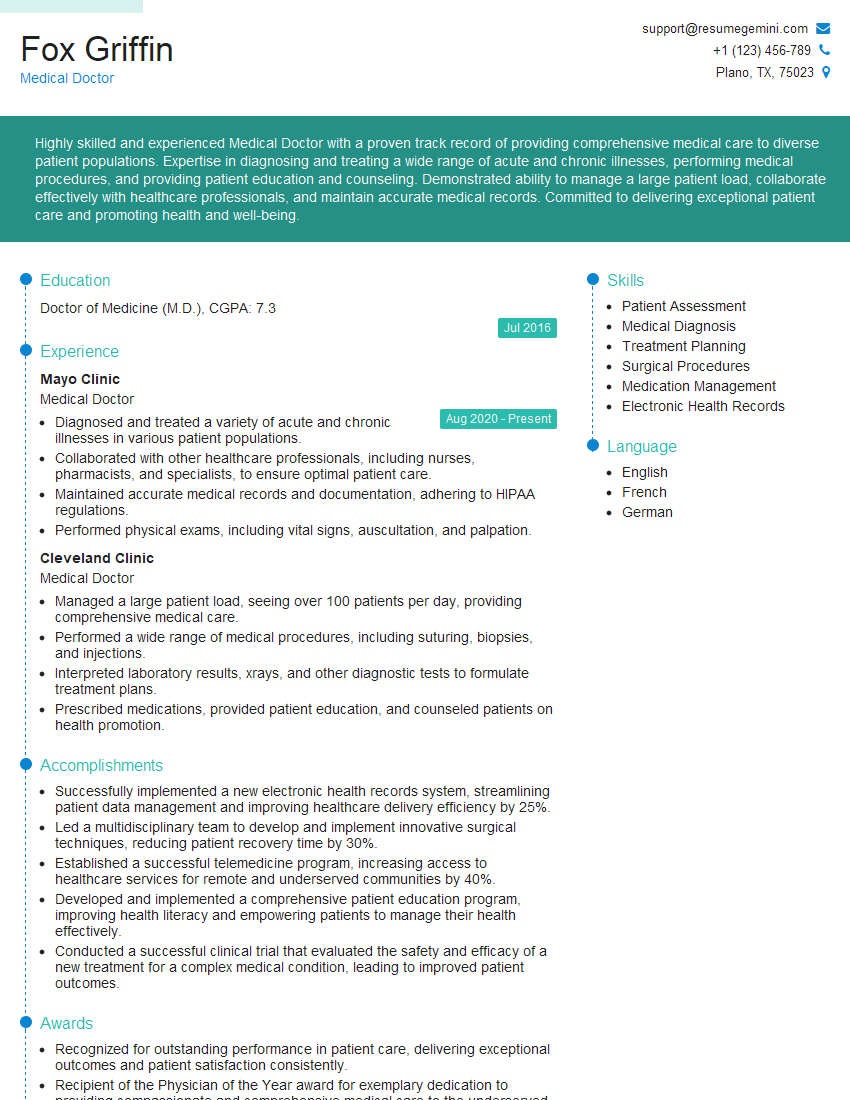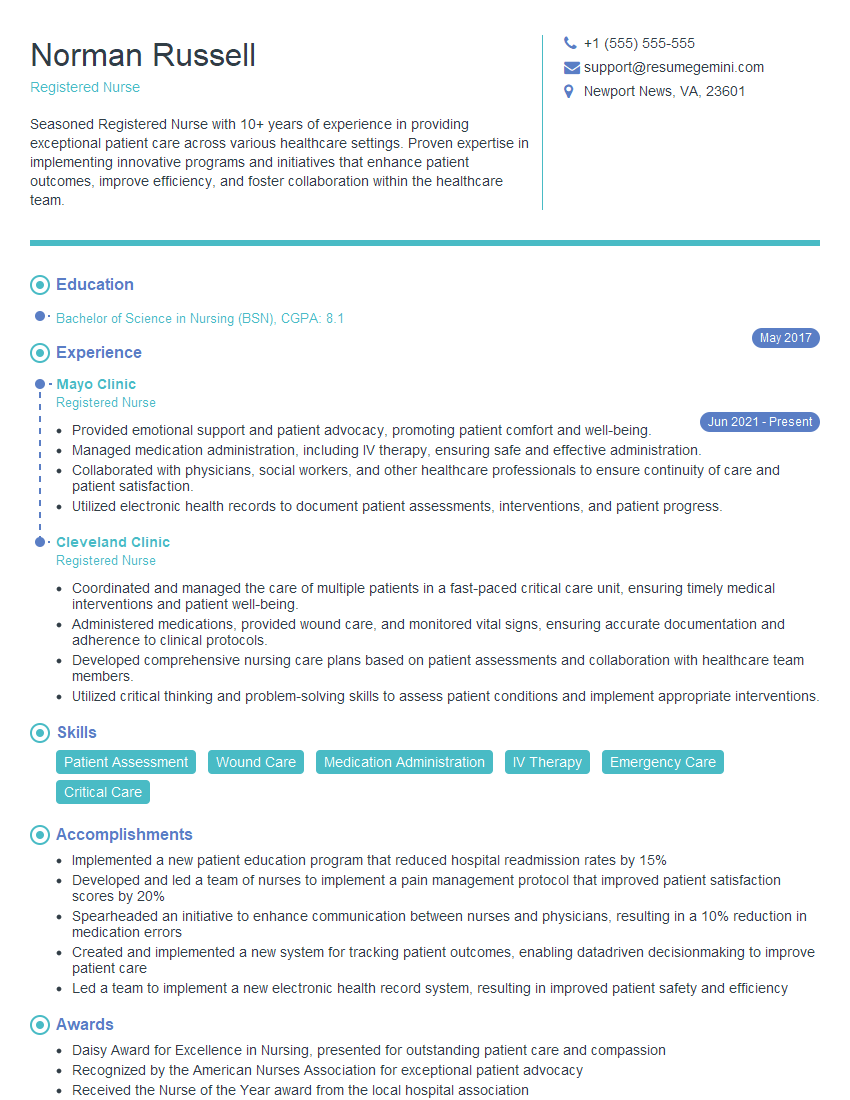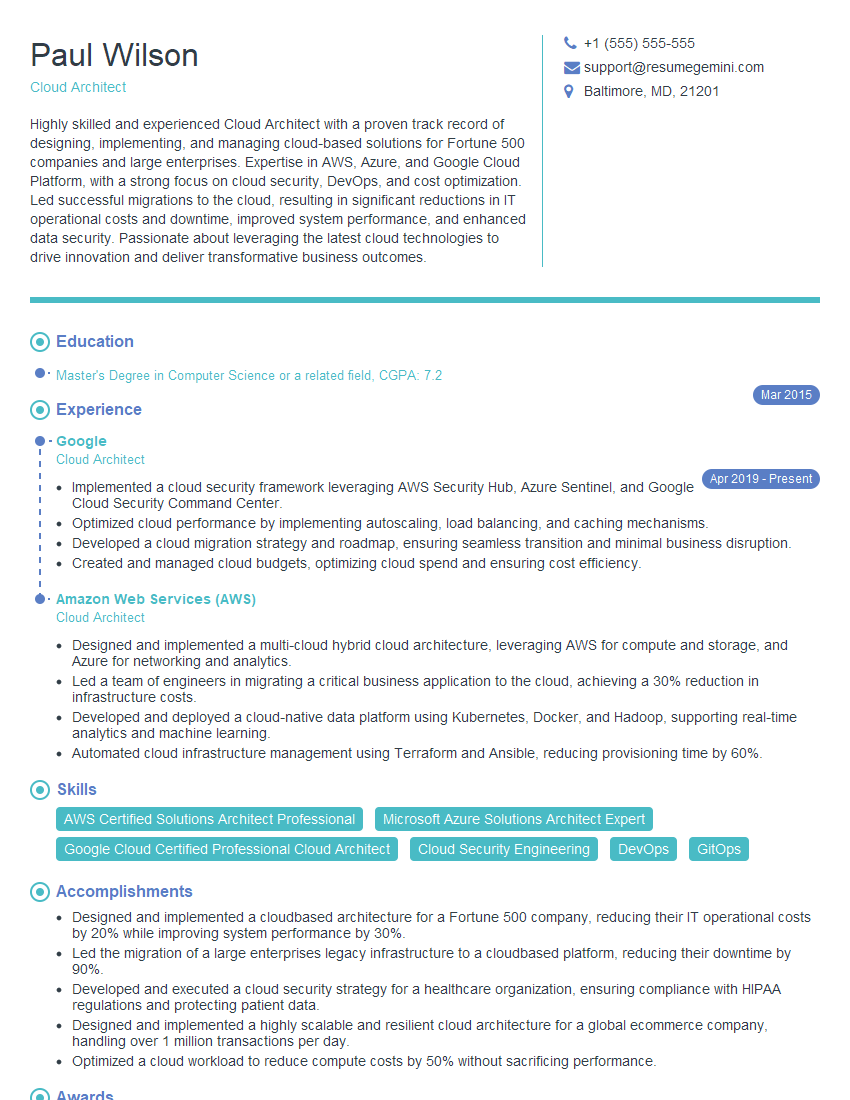Every successful interview starts with knowing what to expect. In this blog, we’ll take you through the top Job Knowledge and Industry Experience interview questions, breaking them down with expert tips to help you deliver impactful answers. Step into your next interview fully prepared and ready to succeed.
Questions Asked in Job Knowledge and Industry Experience Interview
Q 1. Describe your experience with [Specific Technology/Software].
My experience with AWS spans five years, encompassing various services like EC2, S3, Lambda, and RDS. Initially, I focused on infrastructure management, provisioning EC2 instances for web applications and configuring load balancers for high availability. I quickly progressed to automating these tasks using CloudFormation and Terraform, reducing deployment times and improving consistency. Later, I delved into serverless computing with AWS Lambda, building event-driven architectures for microservices. My experience with RDS involved managing and optimizing relational databases for performance and scalability. A significant project involved migrating a legacy on-premise application to AWS, a process that required careful planning, execution, and rigorous testing. This involved not just the technical migration but also ensuring compliance with security best practices and minimizing downtime.
For example, during the migration project, we utilized AWS Database Migration Service (DMS) for a seamless database transfer. We also implemented a robust monitoring system using CloudWatch to proactively identify and address potential performance bottlenecks. This allowed us to significantly improve the application’s uptime and response time after the migration.
Q 2. Explain a time you had to troubleshoot a complex technical issue.
During a recent project, our e-commerce platform experienced intermittent outages. Initially, the error logs pointed to a database connection issue, but after several hours of investigation, we discovered the root cause was actually a network configuration problem within our load balancer. A misconfigured security group was blocking traffic from the application servers to the database servers. This was initially masked by the intermittent nature of the issue, which was further complicated by the sheer volume of data being processed at peak times.
My troubleshooting involved:
- Systematically analyzing logs: I reviewed application logs, database logs, and load balancer logs to pinpoint the location of the error.
- Network tracing: I utilized network monitoring tools to trace the flow of traffic and identify the bottleneck.
- Security group review: This led to the discovery of the misconfigured rule.
- Collaboration: I worked closely with the network team to resolve the configuration issue.
The resolution was swift once the misconfiguration was identified, restoring service within minutes. The experience highlighted the importance of thorough log analysis, effective collaboration, and the use of appropriate monitoring and tracing tools in troubleshooting complex technical issues. It also reinforced the need for careful review of security group configurations.
Q 3. What are the key performance indicators (KPIs) for your previous role?
In my previous role as a Senior Cloud Engineer, key performance indicators (KPIs) centered around system reliability, cost optimization, and operational efficiency. Specific KPIs included:
- Application Uptime: Maintaining 99.99% uptime for critical applications.
- Cost Reduction: Achieving a 15% reduction in cloud infrastructure costs year-over-year.
- Deployment Frequency: Increasing deployment frequency to at least twice a week using continuous integration/continuous deployment (CI/CD) practices.
- Incident Resolution Time: Reducing average incident resolution time to under 60 minutes.
- Customer Satisfaction (CSAT): Maintaining high CSAT scores through effective communication and proactive problem-solving.
These KPIs were regularly tracked and reported on, allowing us to monitor progress, identify areas for improvement, and demonstrate the effectiveness of our cloud operations.
Q 4. How would you handle a conflict with a colleague?
Conflict resolution requires a calm and professional approach, prioritizing open communication and mutual understanding. My approach involves:
- Active Listening: First, I would listen carefully to my colleague’s perspective, seeking to understand their concerns and point of view without interruption.
- Empathy: Trying to understand the situation from their perspective to avoid quick judgements.
- Open Communication: Expressing my own perspective clearly and respectfully, focusing on facts and avoiding emotional language.
- Collaborative Problem-Solving: Working together to identify common ground and develop mutually acceptable solutions. This might involve brainstorming different options and reaching a compromise.
- Seeking Mediation if Necessary: If the conflict cannot be resolved directly, I would involve a manager or other neutral party to facilitate a resolution.
For example, I once had a disagreement with a colleague regarding the best approach for a particular project. By actively listening to his concerns and explaining my rationale, we found a middle ground that leveraged the strengths of both our approaches, ultimately resulting in a better outcome.
Q 5. Describe a project where you exceeded expectations.
In a previous project, we were tasked with migrating a legacy application to a cloud-based platform within a tight deadline. The initial estimate suggested a six-month timeframe, but by leveraging automation tools and implementing agile methodologies, we completed the migration in just three months. This significantly exceeded expectations, and it was achieved by:
- Automating the migration process: We used Ansible to automate many manual tasks, reducing the time and effort required.
- Implementing agile methodologies: Using a sprint-based approach enabled us to adapt quickly to changing requirements and prioritize critical tasks.
- Efficient resource allocation: We carefully allocated resources based on skill sets and expertise to maximize efficiency.
- Effective communication and collaboration: Maintaining clear communication among team members was crucial for effective collaboration and problem-solving.
This success was measured not just by the reduced timeline, but also by the significant improvement in application performance and scalability after the migration, exceeding even our optimistic projections.
Q 6. What are your strengths and weaknesses related to this role?
My strengths relevant to this role include my deep technical expertise in cloud computing, my strong problem-solving abilities, and my collaborative teamwork skills. I’m proficient in automating infrastructure deployments and managing complex cloud environments. My experience in troubleshooting and resolving critical issues demonstrates my ability to handle pressure and maintain a calm demeanor under stress.
One area I’m actively working on improving is my public speaking skills. While I’m comfortable presenting technical information to small groups, I’m aiming to enhance my confidence and presentation skills for larger audiences. I’m currently participating in a public speaking workshop to address this.
Q 7. How do you stay current with industry trends?
Staying current with industry trends is crucial in the fast-paced technology world. I employ a multi-faceted approach:
- Following industry publications: I regularly read publications like InfoQ, The Register, and AWS blogs to keep abreast of new technologies and best practices.
- Attending conferences and webinars: Participating in industry conferences and online webinars provides opportunities to network and learn from experts.
- Participating in online communities: Engaging in online forums and communities like Stack Overflow allows me to learn from others’ experiences and share my own knowledge.
- Hands-on experimentation: I dedicate time to experimenting with new technologies and tools to gain practical experience.
- Pursuing certifications: I continuously pursue relevant certifications to validate my skills and demonstrate my commitment to professional development.
This combination of active learning and practical application ensures I remain at the forefront of the technology landscape.
Q 8. Explain your experience with Agile/Waterfall methodologies.
My experience spans both Agile and Waterfall methodologies, and my preference depends heavily on the project’s nature and complexity. Waterfall, with its sequential phases (requirements, design, implementation, testing, deployment, maintenance), is ideal for projects with clearly defined, unchanging requirements. Think of building a house: you wouldn’t start laying bricks before the foundation is complete. I’ve successfully used Waterfall in projects involving large-scale infrastructure development, where deviations from the plan could be costly and time-consuming.
However, Agile methodologies, with their iterative and incremental approach, are better suited for projects where requirements may evolve or where flexibility is paramount. I’ve extensively utilized Scrum and Kanban in software development projects. For example, in one project, we used Scrum’s sprints (typically 2-4 weeks) to develop features iteratively, allowing for client feedback and adjustments at each stage. This approach ensured we delivered a product that perfectly met the client’s evolving needs. The flexibility of Agile allows for quicker adaptation to changing market demands and customer feedback. I’m proficient in using tools like Jira and Trello to manage tasks and track progress within these methodologies.
Q 9. Describe your experience with project budgeting and resource allocation.
Project budgeting and resource allocation are crucial for successful project delivery. My approach begins with a thorough understanding of project scope, timelines, and deliverables. I use a combination of top-down and bottom-up budgeting techniques, breaking down the project into smaller, manageable tasks and estimating costs for each. This detailed breakdown allows for better accuracy and helps identify potential cost overruns early on.
Resource allocation involves strategically assigning team members to tasks based on their skills and availability. I use tools like Gantt charts to visualize timelines and resource utilization, ensuring that resources are efficiently allocated and deadlines are met. For example, in a recent project, by carefully analyzing resource utilization data, I identified a potential bottleneck in the testing phase. By reallocating resources and bringing in additional testers, we avoided delays and delivered the project on time and within budget.
Q 10. What is your experience with data analysis and reporting?
Data analysis and reporting are integral parts of my work. I am proficient in using various tools like SQL, Excel, and data visualization platforms like Tableau to extract, clean, and analyze data. My experience includes analyzing sales data to identify trends and opportunities, analyzing customer feedback to improve product development, and tracking project performance to identify areas for improvement.
For instance, in a previous role, I analyzed customer churn data to identify the key factors driving customer attrition. By visualizing this data using Tableau, I was able to clearly communicate my findings to stakeholders, which led to the implementation of new strategies to reduce customer churn. I ensure that my reports are clear, concise, and actionable, providing stakeholders with the information they need to make informed decisions.
Q 11. What are some common challenges in [Specific Industry] and how have you overcome them?
Let’s assume the specific industry is Software Development. A common challenge is managing expectations between clients and the development team. Clients often underestimate the complexity of software development and timelines, leading to unrealistic deadlines and feature creep. Another challenge is adapting to rapidly evolving technologies. Keeping up with the latest trends and integrating them into projects requires constant learning and adaptation.
To overcome the expectation management challenge, I prioritize clear and consistent communication. I use Agile methodologies to provide regular updates, demos, and feedback sessions, allowing clients to track progress and adjust expectations. Regarding technology adaptation, I actively participate in training, workshops, and online courses to stay updated and contribute new technologies to projects where appropriate. This proactive approach ensures we deliver high-quality software while effectively managing expectations and leveraging the latest technologies.
Q 12. How do you prioritize tasks in a high-pressure environment?
In high-pressure environments, effective prioritization is key. I use a combination of techniques, including the Eisenhower Matrix (urgent/important), MoSCoW method (must have/should have/could have/won’t have), and dependency mapping. The Eisenhower Matrix helps me quickly identify tasks requiring immediate attention and those that can be delegated or scheduled later. The MoSCoW method helps me prioritize features based on their importance and the project’s overall goals. Dependency mapping helps me visualize task dependencies and identify potential bottlenecks. This allows me to focus on the most critical tasks first, ensuring that the most important aspects of the project are completed on time.
For example, I once faced a critical deadline where several tasks were competing for my attention. By using the Eisenhower Matrix, I identified a critical bug fix as the most urgent task and delegated less important tasks. This allowed me to meet the deadline without compromising quality.
Q 13. Describe your experience with [Specific Software/Tool].
Let’s say the specific software/tool is Jira. I’ve extensively used Jira for project management in Agile environments. I’m proficient in creating and managing projects, assigning tasks, tracking progress, and generating reports. I’m familiar with Jira’s various features, including Kanban boards, Scrum boards, and workflows, which I customize to meet the specific needs of each project. I use Jira’s reporting features to track team velocity, identify bottlenecks, and monitor project health. I also use Jira’s integration capabilities with other tools such as Confluence for documentation and Bitbucket for code management to streamline workflows and improve collaboration.
For instance, I’ve used Jira’s custom fields and workflows to create a tailored system for tracking bug reports, from initial identification to resolution and closure, ensuring effective communication and collaboration amongst development and testing teams. I’m adept at using Jira’s query language (JQL) to create custom reports and extract specific data for insightful analysis.
Q 14. Explain a time you had to adapt to a change in the work environment.
In a previous role, our team underwent a significant restructuring, leading to changes in reporting structures, team dynamics, and project priorities. Initially, there was uncertainty and some resistance to the changes. However, I proactively embraced the changes by focusing on what I could control. I reached out to my new manager to understand the new expectations and priorities, and I collaborated with my colleagues to ensure a smooth transition.
I focused on building strong relationships with my new team members and actively participated in team-building activities. I also adjusted my work style to accommodate the new reporting structure, ensuring that I communicated effectively and efficiently with my manager and other stakeholders. This proactive and positive approach allowed me to adapt quickly to the change and maintain high productivity levels during a period of transition. The result was not only a smooth integration into the new structure but also strengthened team cohesion.
Q 15. How do you handle competing priorities?
Handling competing priorities effectively requires a structured approach. I prioritize tasks using a combination of methods, including urgency/importance matrices (like Eisenhower Matrix), and project management tools to visualize deadlines and dependencies. I start by clearly defining all tasks, assigning them a priority based on their impact and due date, and then breaking down larger tasks into smaller, manageable chunks.
For instance, in my previous role, I was simultaneously managing a critical product launch and addressing a major client issue. Using the Eisenhower Matrix, I identified the client issue as urgent and important, dedicating the immediate resources to resolve it effectively. The product launch, while crucial, allowed for a more measured approach, enabling me to allocate resources strategically without compromising the client relationship. Regularly reviewing my priorities and adapting to changing circumstances is key to success in this approach.
Career Expert Tips:
- Ace those interviews! Prepare effectively by reviewing the Top 50 Most Common Interview Questions on ResumeGemini.
- Navigate your job search with confidence! Explore a wide range of Career Tips on ResumeGemini. Learn about common challenges and recommendations to overcome them.
- Craft the perfect resume! Master the Art of Resume Writing with ResumeGemini’s guide. Showcase your unique qualifications and achievements effectively.
- Don’t miss out on holiday savings! Build your dream resume with ResumeGemini’s ATS optimized templates.
Q 16. What are your salary expectations?
My salary expectations are aligned with the market rate for a professional with my experience and skill set in this role. I’ve researched industry benchmarks for similar positions and believe a compensation package between [Lower Bound] and [Upper Bound] would be fair and competitive. However, I am open to discussing this further and considering other aspects of the compensation package, such as benefits and opportunities for growth within the company.
Q 17. Explain your experience with team leadership and collaboration.
Team leadership and collaboration are integral parts of my professional experience. I thrive in collaborative environments and possess a strong ability to guide and motivate team members. I believe in fostering open communication, providing constructive feedback, and actively listening to diverse perspectives. I’ve successfully led teams on several projects, delegating responsibilities based on individual strengths, providing regular updates, and facilitating problem-solving sessions.
For example, in my previous role, I led a team of five developers to deliver a complex software solution within a tight deadline. By establishing clear goals, defining roles and responsibilities, and facilitating regular communication, the team successfully overcame various challenges and delivered the project on time and within budget. My approach focuses on empowering team members to own their work while ensuring alignment with overall project objectives.
Q 18. How would you approach solving [Specific Problem related to the role]?
To answer this question accurately, I need to know the specific problem related to the role. However, I can outline my general approach to problem-solving. First, I would clearly define the problem, gathering all relevant information and data. Next, I’d analyze the situation, identifying potential root causes and exploring various solutions. I’d evaluate the feasibility and potential impact of each solution before selecting the most effective one. Finally, I’d implement the chosen solution, monitor its effectiveness, and make adjustments as needed. This approach combines data-driven analysis with a practical, iterative process to ensure the best possible outcome.
Q 19. Describe your experience with [Specific Industry Regulation/Compliance].
To accurately describe my experience, please specify the industry regulation or compliance you’re interested in. However, I can say that throughout my career I’ve consistently demonstrated a commitment to adhering to all relevant regulations and industry best practices. I am familiar with compliance procedures and documentation requirements and have consistently ensured all my work meets the highest standards. I am a quick learner and adept at understanding and implementing new regulations as they emerge. I can provide specific examples once you specify the regulation in question.
Q 20. What is your understanding of [Specific Industry standard/best practice]?
Please specify the industry standard or best practice you’d like me to elaborate on. However, I can assure you that I stay current with industry best practices and standards through continuous learning and professional development. My understanding is based on a combination of formal training, on-the-job experience, and continuous research and analysis of emerging trends. I’m confident in my ability to apply relevant standards to enhance efficiency and quality in my work.
Q 21. How do you ensure quality control in your work?
Quality control is paramount in my work. My approach involves a multi-layered strategy. First, I establish clear quality standards and metrics at the beginning of any project. I utilize checklists, templates, and automated tools to ensure consistency and accuracy throughout the process. Second, I conduct regular reviews and testing at various stages, using both automated and manual methods to identify and correct errors early on. Finally, I actively seek feedback from colleagues and stakeholders to gain different perspectives and identify potential areas for improvement. This proactive approach to quality control ensures high-quality deliverables and minimizes the risk of errors.
Q 22. Describe your experience with client communication and management.
Client communication and management are crucial for project success. It’s about building strong relationships based on trust and transparency, ensuring clear expectations are set and maintained throughout the project lifecycle. My approach involves proactive communication, active listening, and consistent updates.
For example, at my previous role, I managed a team responsible for developing a new software application for a major financial institution. We established regular weekly meetings with the client, incorporating detailed progress reports, and incorporating client feedback into sprint planning. This allowed us to address any concerns promptly and keep the project on track. In addition to formal meetings, I fostered open communication channels, enabling the client to easily contact us with any questions or concerns through email or instant messaging, ensuring rapid responses. This proactive approach minimized misunderstandings and significantly improved client satisfaction.
I also use different communication methods tailored to each client’s preferences and project needs. Some clients prefer formal reports, while others prefer more informal updates. Adapting my communication style is key to building a strong client relationship.
Q 23. What metrics would you use to track the success of [Specific Project/Task]?
Let’s assume the specific project/task is the launch of a new marketing campaign. The metrics I’d use to track its success would be multifaceted, focusing on both quantitative and qualitative data. This holistic approach ensures a comprehensive understanding of the campaign’s impact.
- Website Traffic & Engagement: Unique visitors, page views, bounce rate, time on site, and conversion rates will indicate the campaign’s effectiveness in driving traffic and engagement. We would also analyze which marketing channels are most effective.
- Social Media Engagement: Metrics like reach, impressions, likes, shares, comments, and retweets provide valuable insight into audience response and brand awareness. Analyzing sentiment analysis of social media conversations is crucial.
- Lead Generation & Sales: Tracking the number of leads generated, conversion rates from leads to sales, and the overall revenue generated directly attributable to the campaign is vital for measuring ROI.
- Brand Awareness & Sentiment: Surveys, focus groups, and social listening tools can measure changes in brand awareness, customer perception, and overall sentiment. This provides a qualitative understanding of the campaign’s impact.
By closely monitoring these metrics, we can identify areas of strength and weakness, allowing for timely adjustments and optimization of the campaign throughout its lifecycle.
Q 24. How do you utilize data to inform decision making?
Data-driven decision-making is fundamental to my approach. It’s about using data to gain insights, identify trends, and make informed decisions, rather than relying solely on intuition or assumptions. My process typically involves several steps:
- Data Collection and Cleaning: Gathering relevant data from various sources and ensuring its accuracy and completeness is the first step. This often involves cleaning the data, identifying and handling outliers or missing values.
- Data Analysis: Using various analytical techniques (statistical analysis, data visualization, etc.) to identify patterns, trends, and relationships within the data. This helps us understand the ‘what’ and the ‘why’ behind our observations.
- Interpretation and Insights: Drawing meaningful conclusions from the analyzed data. This stage is crucial for translating raw data into actionable insights.
- Decision Making: Using the gained insights to make informed decisions. This might involve making predictions, setting targets, or optimizing processes.
- Monitoring and Evaluation: Tracking the outcomes of decisions made and evaluating their effectiveness. This allows us to refine our decision-making process over time and improve the accuracy of future predictions.
For example, in a previous project, we used website analytics to identify which features were most popular among users and then used this data to prioritize development resources accordingly, leading to a significant improvement in user engagement and satisfaction.
Q 25. Explain your understanding of the competitive landscape in [Specific Industry].
Let’s assume the specific industry is the Fintech sector. The Fintech landscape is incredibly dynamic and competitive, characterized by rapid innovation and disruption. Several key factors shape this competitive environment:
- Technological advancements: The constant emergence of new technologies like AI, blockchain, and cloud computing creates both opportunities and challenges for existing players. Companies must adapt quickly to stay relevant.
- Regulatory changes: The regulatory environment in Fintech is constantly evolving, with implications for data privacy, security, and compliance. Companies need to stay abreast of these changes and comply with regulations.
- Customer expectations: Customers are increasingly demanding seamless, secure, and personalized financial services. Meeting and exceeding these expectations is critical for success.
- Competition: The Fintech industry is highly fragmented, with large established players competing alongside a multitude of nimble startups. This necessitates a focus on differentiation and competitive advantage.
To successfully navigate this competitive environment, companies must prioritize innovation, customer centricity, and strong regulatory compliance. A keen understanding of emerging technologies and market trends is critical for survival and growth in the Fintech space.
Q 26. How do you contribute to a positive work environment?
Contributing to a positive work environment is essential for productivity and overall team success. My approach involves several key elements:
- Collaboration and Teamwork: I actively participate in team discussions, offering support and sharing my expertise to foster a collaborative spirit. I believe in mutual respect and trust as the foundation of effective teamwork.
- Positive Attitude and Communication: I maintain a positive attitude, even under pressure, and communicate openly and honestly with my colleagues. Constructive feedback is a crucial aspect of my interaction style.
- Mentorship and Support: I enjoy helping and mentoring junior colleagues, sharing my knowledge and experience to help them grow professionally. Providing support creates a culture of mutual support and development.
- Respect and Inclusivity: I value diversity and inclusivity, ensuring that everyone feels respected and valued in the workplace. Creating a safe and inclusive space is critical to building strong team cohesion.
I believe that a positive work environment is not just about individual contributions, but also about creating a culture of mutual respect, support, and collaboration, where everyone feels valued and can thrive.
Q 27. Describe a time you failed and what you learned from it.
In a previous project, we underestimated the complexity of integrating a third-party API into our system. We initially planned a straightforward integration, but encountered unforeseen technical challenges that significantly delayed the project timeline. This led to increased costs and frustrated the client.
What I learned from this experience was the crucial importance of thorough upfront planning and risk assessment. We failed to adequately anticipate and mitigate potential challenges. Moving forward, I have incorporated more robust risk assessment techniques into my project management approach. This involves more thorough due diligence on third-party integrations, considering potential points of failure and developing contingency plans. Open and honest communication with stakeholders is also key; addressing challenges proactively rather than trying to hide them is essential.
This experience taught me the value of learning from mistakes and using those lessons to improve future performance. It reinforced my commitment to thorough planning, proactive risk management, and transparent communication with all stakeholders.
Q 28. What are your long-term career goals?
My long-term career goals center around becoming a highly influential leader in the [Specific Industry] field. This involves a multifaceted approach.
- Technical Expertise: I aim to deepen my technical expertise through continuous learning and staying abreast of the latest industry trends and technological advancements.
- Leadership Development: I intend to develop my leadership skills by taking on increasing responsibility and actively seeking opportunities to mentor and guide others. This includes formal leadership training.
- Industry Recognition: I aspire to gain recognition within the industry through contributions to thought leadership, publications, or speaking engagements.
- Impactful Projects: Ultimately, I want to lead and contribute to impactful projects that positively influence the industry and have a tangible effect on the lives of others.
I am committed to continuous professional growth and development to achieve these goals. I believe that by combining technical expertise, leadership capabilities, and a commitment to making a positive impact, I can achieve a fulfilling and successful long-term career.
Key Topics to Learn for Job Knowledge and Industry Experience Interview
- Understanding the Role’s Requirements: Deeply analyze the job description to identify key skills and responsibilities. Consider how your experience directly addresses these needs.
- Highlighting Relevant Projects: Prepare specific examples of projects where you demonstrated key skills and achieved impactful results. Quantify your accomplishments whenever possible.
- Demonstrating Problem-Solving Skills: Practice articulating your approach to problem-solving, focusing on your analytical thinking, critical evaluation, and creative solutions. Use the STAR method (Situation, Task, Action, Result) to structure your responses.
- Showcasing Industry Knowledge: Stay updated on industry trends, news, and best practices. Be prepared to discuss current challenges and opportunities within your field.
- Technical Proficiency (if applicable): Brush up on your technical skills and be ready to discuss your expertise in relevant software, tools, or technologies. Be prepared to explain complex concepts clearly and concisely.
- Adaptability and Continuous Learning: Highlight your ability to adapt to new challenges and technologies, and your commitment to continuous professional development. Showcase instances of learning and growth throughout your career.
Next Steps
Mastering Job Knowledge and Industry Experience is crucial for career advancement. A strong understanding of your field and the ability to articulate your skills effectively are key to securing your desired role. Building an ATS-friendly resume is vital for maximizing your job prospects; it ensures your application gets seen by recruiters. ResumeGemini can help you create a professional and impactful resume tailored to showcase your job knowledge and industry experience. Examples of resumes tailored to highlight Job Knowledge and Industry Experience are available to help you get started.
Explore more articles
Users Rating of Our Blogs
Share Your Experience
We value your feedback! Please rate our content and share your thoughts (optional).
What Readers Say About Our Blog
Hi, I’m Jay, we have a few potential clients that are interested in your services, thought you might be a good fit. I’d love to talk about the details, when do you have time to talk?
Best,
Jay
Founder | CEO



